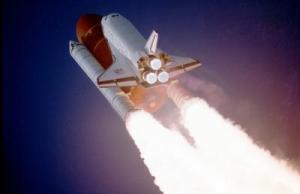By George Alexander
I began covering the space shuttle project in 1972, soon after President Nixon authorized it. I had recently joined this newspaper (Los Angeles Times) as a science writer. And the country was enthusiastic about the idea of a reusable spacecraft, which was expected to be sturdy, economical, and reliable.
The shuttle turned out to be neither economical nor sturdy, and its reliability has been wobbly. But as I watched the shuttle Atlantis blast off into space on what will be the 135th and final space shuttle mission, I found myself feeling a bit nostalgic.I was at Cape Canaveral for the shuttle Columbia’s first flight in April 1981, and I covered many other shuttle missions. Launches were always exhilarating, but they also meant exhausting work schedules. Afraid to miss something, we “newsies” sat up at the Johnson Space Center in Houston, where Mission Control was located, drinking terrible coffee and waiting for the intermittent crackle of an astronaut’s voice from orbit.
Sometimes a report was designed for mass consumption. On the first shuttle flight, astronaut John Young spoke in a televised broadcast from Columbia’s cabin. “I think we really have something that’s going to mean [a lot] to the nation and to the world,” he said.
But most of the communications from on high were terse, cryptic comments in a lingua franca known only to astronauts and the mission controllers: To the journalists, these fragmentary transmissions sounded something like this:
“Houston, OK, we’ve got the maguffin aligned and are about to activate it.”
“Roger.”
“But it looks like it’s reading a little high.”
“Copy that.”
With luck, there might be a NASA public affairs person who could translate for us, but more often than not, we’d have to wait for the change-of-shift briefing to find out what a “maguffin” was and whether the high reading was newsworthy.
Even before the first shuttle launch, the program had claimed lives. Several weeks before Columbia took off, workers entered a nitrogen-filled shuttle chamber during a fuel test. Two of them died.
Of the 134 shuttle missions launched before this final one, two ended in tragedy: Challenger, which was engulfed in a fireball 73 seconds after launch in 1986; and Columbia, which disintegrated over Texas just 16 minutes before it was due to land at the Cape Canaveral spaceport in 2003.
There were also five missions that came gaspingly close to disaster. In each of them, during the seconds between the start of the shuttle’s three liquid-fueled engines and the start of its two huge solid-propellant rocket motors, computers sensed something amiss with the engines and shut everything down, averting almost certain catastrophe.
And at least a dozen other missions could have ended badly, even fatally, because of problems that developed during flight or on takeoff or landing. There were damaged heat-shield tiles, a blown tire, brake failure, leaky chemicals.
But in the shuttle program’s 30 years of flights, there were also triumphs. The Hubble Space Telescope was launched in 1990, and five later shuttles between 1993 and 2009 were successfully dispatched to repair and refurbish this wonderful instrument. Shuttles launched two planetary probes, Magellan and Galileo, which went on to Venus and Jupiter, respectively.
The five space shuttles — Columbia, Challenger, Atlantis, Discovery, and Endeavor — hauled hundreds of astronauts and some 3,500 tons of satellites, deep-space probes, science experiments, and prefab segments of the International Space Station into low-Earth orbit.
Indeed, over the last decade, Atlantis, Discovery, and Endeavor have been so given over to delivering parts, provisions and people to the station that NASA could well have been excused if it had painted the black-and-white vehicles UPS brown instead.
So, has it been worth it? The loss of 14 men and women aboard Challenger and Columbia? The $290 billion spent building, testing, and operating the vehicles?
There aren’t clear answers to these questions. Yes, the shuttles have demonstrated that humans can perform useful work in space. But they have also consumed a vast portion of NASA’s budget, especially after the Challenger and Columbia disasters, when the agency had to come up with billions of dollars and several years of down time to get back on track. Some promising robotic and aeronautical programs were forced to take a back seat to the shuttle program.
In the last two decades, we’ve gotten markedly different returns on our investments in space: Robots have flown circles around the planets Jupiter and Saturn; rovers have traversed Mars’ rusty-red plains; and the Hubble telescope has seen extraordinary objects and processes deep in space. Conversely, the space station, only now being completed, years late and tens of billions of dollars over budget, has yet to show any appreciable results. The shuttle has also had a mixed bag of accomplishments.
Looking back on the shuttle program, I think it’s clear that there are valid roles for humans in space, but it’s hard not to conclude that some shuttle missions have felt like make-work projects undertaken more to keep astronauts in orbit rather than because they were essential. With the shuttle program’s retirement (space station-bound astronauts will ride Russian rockets for the next few years), let’s take the time to analyze our goals in space, and then to ask ourselves if sending more humans aloft is really necessary to accomplish them.
“Assessing the space shuttle program,” Los Angeles Times Op-Ed, July 10, 2011.
_George Alexander was the Los Angeles Times’ science writer from 1972 to 1985. He is also a past president of NASW.
(NASW members can read the rest of the Summer 2011 ScienceWriters by logging into the members area.)




